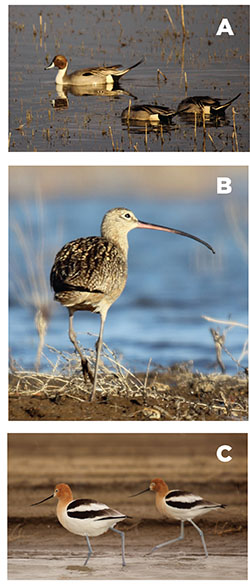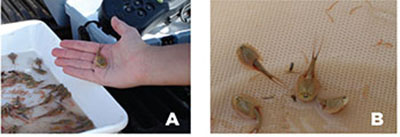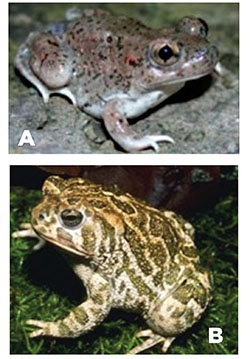Guide W-107
Rossana Sallenave and Amy Ganguli
College of Agricultural, Consumer and Environmental Sciences, New Mexico State University
Authors: Respectively, Extension Aquatic Ecology Specialist, Department of Extension Animal Sciences and Natural Resources, New Mexico State University; former Associate Professor, Department of Animal and Range Sciences, New Mexico State University and currently National Program Leader, National Institute of Food and Agriculture, U.S. Department of Agriculture. (Print Friendly PDF)
What are Playa Lakes?
Playa lakes are one of the most important types of ephemeral or temporary wetlands in the arid Southwest (Figure 1). These shallow, generally circular depressions with clay-lined basins form at the lowest point in an enclosed watershed. They can range in size from a few acres to up to 200 acres. Because they are closed basins, the only water playas receive is from precipitation and catchment runoff, while water is lost via evaporation from soil and vegetation and recharge of the underlying aquifer. Playa lakes can remain dry for several years—even decades (Figure 2). Then, after a rainfall event, they can fill with up with water and create temporary wetlands. In New Mexico, ephemeral or non-perennial waters make up over 80% of the state’s waters and are expressly protected by the state’s water quality standards. Although playas exist in arid regions throughout the world, the High Plains of the U.S. has the world’s highest number of playas (as many as 50,000), of which 85% are found on the Llano Estacado, a portion of the Southern High Plains spanning the Texas–New Mexico border. In the Southern High Plains region, playas are the principal source of surface water.

Figure 1. Playa lakes, like this one near Portales, NM, provide critical habitat for migratory waterfowl and shorebirds. (Photo courtesy of William Jaremko-Wright, New Mexico Highlands University.)
Because playas store water in parts of the country that receive very little rainwater and where there are no permanent rivers or streams, they are vital to communities, ranchers, and rural agricultural economies, and support a vast array of wildlife. Despite their ephemeral nature, these water resources provide critical ecosystem services, such as recharging groundwater supplies for a growing population; providing habitat for migratory birds, waterfowl, and other wildlife; and supporting a growing wildlife-related recreational industry.

Figure 2. A dry playa near Watrous, NM.
Playas Provide Ecosystem Services
The term “ecosystem services” refers to the many different benefits provided to humans by ecosystems. Examples of ecosystems include agroecosystems, grassland ecosystems, and aquatic ecosystems. Healthy playa wetlands provide numerous ecosystem services that benefit society, including wildlife habitat, clean water, floodwater storage, and groundwater recharge.
Wildlife and biodiversity
Playas are sources of great plant and animal biodiversity, providing critical habitat for millions of migratory birds and waterfowl, as well as providing essential habitat for amphibians, reptiles, mammals, and several species of unique invertebrates (MacKay et al., 1990; Haukos and Smith, 1994). In New Mexico, ephemeral playas have been identified by the New Mexico Department of Game and Fish (2016) as one of ten key aquatic habitats, and they provide habitat for several threatened and endangered species and species of concern in New Mexico. In the Southern High Plains, playa wetlands are essential staging and feeding areas in one of the most important inland migratory corridors in North America for birds, including waterfowl, shorebirds, and many other migratory and resident birds (Figures 3A–3C). They also provide cover and habitat for native species during dry cycles.

Figures 3A–C. Playa wetlands are essential staging and feeding areas for migrating waterfowl, such as northern pintail (A), and shorebirds, such as long-billed curlew (B) and American avocet (C). (Photos courtesy of William Jaremko-Wright, New Mexico Highlands University.)
In addition to their importance to birds, playas support a remarkable variety of invertebrate species that have evolved to exploit the extreme hydrological conditions of these wetlands. Tadpole shrimp and fairy shrimp (Figures 4A and 4B) are primitive branchiopod crustaceans that bridge periods of drought by laying drought-resistant, resting eggs or cysts that can lie dormant and viable for years in unflooded soil (Brendonck, 1996; Brendonck and Meester, 2003). Soon after being immersed in water, a portion of the eggs will hatch, and within a few weeks adult tadpole and fairy shrimp lay eggs before the ephemeral waterbodies dry up again. These crustaceans are important sources of food for some insects, amphibians, and waterfowl, making them an extremely important link in the food web, particularly as a supply of energy for migratory birds (Smith, 2003).

Figures 4A and 4B. Tadpole shrimp (held in hand on left) and fairy shrimp (orange-colored in left photo, in upper right-hand corner in right photo) collected from a playa lake near Las Cruces, NM.
Playa wetlands also provide critical habitat for a number of amphibian species native to the Southwest, particularly anurans (frogs and toads). During most of the year, desert anurans are underground in burrows. However, immediately after the summer monsoon rains, they emerge from their burrows and can be heard calling from newly filled sites. Anuran species that have been observed in both natural playas and human-made cattle tanks in New Mexico include the Mexican spadefoot (Spea multiplicata), plains spadefoot (Spea bombifrons), Couch’s spadefoot (Scaphiopus couchii), Great Plains toad (Anaxyrus cognatus), and green toad (Anaxyrus debilis) (Figures 5A and 5B).

Figures 5A and 5B. Playa wetlands provide critical habitat for a number of amphibian species, including Mexican spadefoot (A) and Great Plains toad (B). (Photos courtesy of Dr. Wiebke Boeing, New Mexico State University.)
Aquifer recharge and water quality
Playas have been shown to be a primary source of groundwater recharge in arid regions. In the High Plains, playas are critical zones of recharge for the Ogallala Aquifer (also known as the High Plains Aquifer) as the water filters through cracks in the playas’ clay lining and back into the aquifer. The Ogallala Aquifer is a vast underground water-bearing formation that spans 174,000 square miles in parts of eight states, including six counties in eastern New Mexico. The aquifer provides almost all the water used in the region. However, current usage far outpaces its ability to recharge. Recharge occurs from within the playa basins as well as along the perimeters of undisturbed playas. Although the exact amount of recharge attributable to any single playa or group of playas is unknown, some studies suggest that recharge rates in unaltered playa basins may be greater than 3 inches per year (Gurdak and Roe, 2009).
In addition to contributing to the significant recharge of aquifers, healthy playas also improve the quality of that water. Studies have shown that playa lakes in their natural state surrounded by buffers of native grasses and vegetation can catch and filter sediments and slow runoff, which allows salts and contaminants to be intercepted before entering the playas. These natural buffers also intercept sediments and prevent them from clogging playas’ natural clay bottoms, which affects infiltration of water.
Threats to the Ecosystem Services Provided by Playas
Changes in land use, primarily as a result of agriculture and urbanization, have led to widespread losses and deterioration of playa wetlands (Haukos and Smith, 1994; Hall et al., 2004). Common impairments to playas include sedimentation (considered to be the greatest threat) and contamination from urban and agricultural runoff, both of which affect playas’ integrity and function. Urban expansion has resulted in many playas being filled, leveled, and bisected with roads. Urban playas have often been used to store stormwater accumulation from urban runoff. Common contaminants in urban runoff include heavy metals, hydrocarbons, pesticides, fertilizers, and chemicals associated with automobiles. Because urban playas rarely have adequate vegetative buffers to intercept surface runoff, these pollutants become concentrated in playas, and can contaminate underlying aquifers.
Rural playas are often altered by creating pits within the playas to hold water long enough to provide drinking water for livestock and to use for irrigation water. Over 70% of playas in the Southern High Plains larger than 10 acres have pits. Other playas have been plowed and cultivated during dry cycles to increase acreage. Modifying the playas in these ways breaks up the clay soils lining the bottom of unaltered playas and removes the grassy buffers along the playa perimeters, leading to increased sedimentation and erosion. This increased sedimentation, coupled with the breakup of the clay layer, prevents cracks from forming in the bottoms of playas, thereby reducing or restricting water infiltration and aquifer recharge. In other areas, such as West Texas, playas are often used to catch runoff from oil and gas operations.
Unsustainable rangeland management practices, such as poorly managed grazing, have also led to the deterioration of many rural playa wetlands. If not managed properly, grazing can result in reduced water quality through a reduction of the valuable filtering capacity of playa vegetation. In addition, heavy use by livestock can result in soil erosion and sedimentation, as well as soil compaction. Higher levels of grazing result in a shift from perennial and more intact plant communities toward annuals.
Protecting these ephemeral wetlands is further complicated by the fact that they are almost entirely located on privately owned lands, leading to a lack of consistent management strategies among playas.
How Can We Protect and Improve Playa Lakes?
Conservation practices
Because unsustainable land use practices and activities surrounding playa wetlands have led to their deterioration, playas should be actively managed in order to maintain and improve their functions, the critical wetland habitat they provide, and groundwater recharge. A number of conservation practices can be implemented by playa owners to help improve natural playa functions.
- Practice improved grazing management. Both forage production and playa fillings are linked to wetter climatic cycles, and therefore overlap. During these grazing windows, the negative effects of intense livestock use of playas can be mitigated through practices such as herding, or implementing grazing systems that allow for deferrals so livestock can be moved to other areas during these critical times. Other strategies include developing alternative upland watering systems, and fencing to manage livestock around a playa.
- Plant and protect vegetative buffers around playas to filter sediments and prevent other contaminants from reaching the playa.
- Remove exotic/invasive plants and promote natural plant communities.
- Remediate (fill) pits with appropriate soils in playa bottoms.
These management practices aimed at conserving and restoring playa wetlands all help create wildlife habitat and natural playa plant communities, improve natural playa function, and promote groundwater recharge. Another important consideration regarding playa restoration is that most playas are on private property, and the impacts of playa wetland deterioration may cross landowner property boundaries. Therefore, restoration efforts will require collaborative partnerships between landowners, conservationists, and funding entities to adequately address playa impairments. Examples of collaborative playa restoration projects in eastern New Mexico are detailed in the Wetlands Action Plan for Playa Lakes, Curry County, New Mexico (Martin, 2014).
Get involved, become informed, and spread the word!
In comparison to other wetlands, playas and the role they play are not well understood. As a result, they are underappreciated and often overlooked, even by some playa landowners. Outreach efforts play a critical role in informing and educating the public on the importance of playa wetlands, as well as in engaging and maintaining community support for conservation efforts of playas. Conservation efforts focus on reducing sedimentation, improving water quality, and restoring playa function and ecological integrity. A great place to begin learning more about playas is by visiting the non-profit organization Playa Lakes Joint Venture (https://pljv.org/), a regional partnership of federal and state agencies, conservation groups, and private industry whose purpose is to conserve bird habitat throughout the western Great Plains, where playas (more than 80,0000) are the most abundant wetland in the region.
Available Playa Assessment and Restoration Resources
A number of federal and state programs exist that provide technical and financial assistance to landowners interested in restoring playas on their properties and protecting the land from future development.
The USDA-Natural Resources Conservation Service (NRCS) provides technical and financial support to landowners with wetland restoration efforts through the Wetlands Reserve Program (WRP; https://www.nrcs.usda.gov/wps/portal/nrcs/detail/national/home/?cid=STELPRDB1049327). This voluntary program assists landowners who wish to protect, restore, and enhance wetlands on their property. Although not all playas meet the wetland criteria required by WRP, many playas may be eligible for the program, and landowners are encouraged to consider the program to enhance their wetland.
The WRP also offers landowners the opportunity to protect, restore, and enhance wetlands on their property through the purchase of a wetland reserve easement. Wetland reserve easements are designed to provide landowners with a financial incentive to restore degraded wetlands. NRCS pays an easement fee and the entire cost to restore the wetland; the owner retains title, access control, and hunting rights, but must protect the wetland for future generations. More information on wetland easement programs, eligibility, and how to enroll can be found at https://www.nrcs.usda.gov/wps/portal/nrcs/detail/null/?cid=nrcseprd416653.
The Environmental Quality Incentives Program (EQIP; https://www.nrcs.usda.gov/wps/portal/nrcs/main/national/programs/financial/eqip/) is another NRCS voluntary program available to agricultural producers who want to improve and protect the condition of their land. The program provides financial and technical assistance to implement structural and conservation practices that address natural resource (soil, water, plants, animals) concerns. The costs are typically shared by the landowner and NRCS, with landowners providing 25% and NRCS providing 75%. Requests by landowners are awarded based on a ranking system and availability of funds.
In New Mexico
The Wetlands Program of the New Mexico Environment Department’s (NMED) Surface Water Quality Bureau (SWQB) (https://www.env.nm.gov/surface-water-quality/wetlands/) promotes the protection and restoration of different types of wetland ecosystems throughout New Mexico, including ephemeral wetlands such as playas. The program assists communities, local governments, stakeholders, and others with technical information, planning, training, and other guidance in their wetlands restoration efforts. Examples of playa restoration projects in eastern New Mexico that involved collaborative efforts of landowners, local government, NMED, and the Nature Conservancy are detailed in the Wetlands Action Plan for Playa Lakes, Curry County, New Mexico (Martin, 2014). This wetland action plan provides a summary of programs available to help landowners utilize their playas while protecting their natural functions and ecological integrity. Other programs and sources of funding that have been used by playa landowners in eastern New Mexico to restore playas include the U.S. Fish and Wildlife Service (USFWS) Private Stewardship Grants Program (https://training.fws.gov/courses/csp/csp3115/resources/ESA_Folder/private_stewardship5_04.pdf) and the USFWS North American Wetlands Conservation Act (NAWCA; https://www.fws.gov/birds/grants/north-american-wetland-conservation-act/standard-grants.php).
The New Mexico Rapid Assessment Method (NMRAM) Playa Wetland Field Guide (Muldavin et al., 2017) is a useful guide for resource managers to help assess funding needs of any playa restoration project. It provides procedures for conducting a rapid assessment of playa wetlands in the Southern High Plains of eastern New Mexico. This should help NMED prioritize wetlands in need of restoration, identify causes of degradation, and help develop methods for protecting playas. Details of the field guide can be found at https://www.env.nm.gov/wp-content/uploads/sites/25/2018/04/Playa-RAM-Field-Guide-with-Appendices.pdf.
Summary
Playa lakes are one of the most important types of ephemeral or temporary wetlands in the arid and semi-arid Southwest. Despite their ephemeral nature, these critical water resources recharge groundwater supplies for a growing population; provide habitat for migratory birds, waterfowl, and other wildlife; and support a growing wildlife-related recreational industry. In the Southern High Plains region, playas are the principal source of surface water and are vital to communities, ranchers, and rural agricultural economies. Unfortunately, changes in land use, primarily as a result of agriculture and urbanization, have led to widespread losses and deterioration of playa wetlands. Common impairments to playas include sedimentation (considered to be the greatest threat), pits (deep holes excavated in the basin of the playa), and contamination from urban and agricultural runoff, all of which affect the integrity and function of playas.
Active management of playas is needed to maintain and improve their functions, groundwater recharge, and the critical wetland habitat they provide. A number of conservation practices can be implemented by playa owners to help improve natural playa functions. These management practices all help create wildlife habitat and natural playa plant communities, improve natural playa function, and promote groundwater recharge. Since most playas are on private property, restoration efforts will require collaborative partnerships between landowners, conservationists, and funding entities to adequately address playa impairments.
A number of federal and state programs exist that provide technical and financial assistance to landowners interested in restoring playas on their properties and protecting the land from future development. The USDA-Natural Resources Conservation Service (NRCS) and U.S. Fish and Wildlife Service (USFWS) have a number of programs and grants available for the restoration and protection of playa wetlands. In New Mexico, the Wetlands Program of the New Mexico Environment Department’s (NMED) Surface Water Quality Bureau (SWQB) promotes the protection and restoration of different types of wetland ecosystems throughout New Mexico, including playas.
Acknowledgments
This material is based upon work that is supported by the USDA National Institute of Food and Agriculture, Agricultural and Food Research Initiative Competitive Program, Climate and Land Use, grant #2018-68002-28109; and the USDA National Institute of Food and Agriculture under award number 2017-38640-26913 through the Western Sustainable Agriculture Research and Education program under project number OW18-034. USDA is an equal opportunity employer and service provider. Any opinions, findings, conclusions, or recommendations expressed in this publication are those of the author(s) and do not necessarily reflect the view of the U.S. Department of Agriculture.
References Cited
Brendonck, L. 1996. Diapause, quiescence, hatching requirements: What can we learn from large freshwater branchiopods (Crustacea: Branchiopoda: Anostraca, Notostraca, Conchostraca). Hydrobiologia, 320, 85–97.
Brendonck, L., and L. De Meester. 2003. Egg banks in freshwater zooplankton: Evolutionary and ecological archives in the sediment. Hydrobiologia, 491, 65–84.
Dennehy, K.F. 2000, August. High Plains regional ground-water study [USGS Fact Sheet FS-091-00]. U.S. Department of the Interior, U.S. Geological Survey. https://pubs.usgs.gov/fs/2000/0091/report.pdf
Gurdak, J.J., and C.D. Roe. 2009. Recharge rates and chemistry beneath playas of the High Plains aquifer—A literature review and synthesis [Circular 1333]. U.S. Department of the Interior, U.S. Geological Survey.
Haukos, D.A., and L.M. Smith. 1994. The importance of playa wetlands to biodiversity of the Southern High Plains. Landscape and Urban Planning, 28, 83–98.
MacKay, W.P., S.J. Loring, T.M. Frost, and W.G. Whitford. 1990. Population dynamics of a playa community in the Chihuahuan desert. Southwest Naturalist, 35, 393–402.
Martin, R. 2014, June. Wetlands action plan for playa lakes, Curry County, New Mexico. New Mexico Environment Department, Surface Water Quality Bureau. https://www.env.nm.gov/wp-content/uploads/sites/25/2017/07/Wetlands-Action-Plan-Playa-Lakes-Curry-County-NMFinal.pdf
Muldavin, E.H., E.R. Milford, and M.M. McGraw 2017. New Mexico rapid assessment method: Playa wetlands field guide, ver. 1.2. New Mexico Environment Department, Surface Water Quality Bureau. https://www.env.nm.gov/wp-content/uploads/sites/25/2018/04/Playa-RAM-Field-Guide-with-Appendices.pdf
New Mexico Department of Game and Fish. 2016, November 22. State wildlife action plan for New Mexico. https://www.wildlife.state.nm.us/download/conservation/swap/New-Mexico-State-Wildlife-Action-Plan-SWAP-Final-2019.pdf
Smith, L.M. 2003. Playas of the Great Plains. Austin: University of Texas Press.
Smith, L.M., D.A. Haukos, S.T. McMurry, T. LaGrange, and D. Willis. 2011. Ecosystem services provided by playas in the High Plains: Potential influences of USDA conservation programs. Ecological Applications, 21, supplement: S82–S92.
For Further Reading
W-104: Understanding Water Quality Parameters to Better Manage Your Pond
https://pubs.nmsu.edu_w/W104/
W-105: Understanding and Preventing Fish Kills in Your Pond
https://pubs.nmsu.edu/_w/W105/
W-106: Cyanobacteria (Blue-green Algae) in Our Waters: Agricultural best management practices (BMPs) to increase resilience to algal blooms
https://pubs.nmsu.edu/_w/W106/

Rossana Sallenave is an Extension Aquatic Ecology Specialist at New Mexico State University. She earned her Ph.D. at the University of Guelph in Canada. Her research interests include aquatic ecology and ecotoxicology. Her Extension goals are to educate and assist New Mexicans on issues relating to watershed stewardship and aquatic ecosystem health.
To find more resources for your business, home, or family, visit the College of Agricultural, Consumer and Environmental Sciences on the World Wide Web at pubs.nmsu.edu.
Contents of publications may be freely reproduced, with an appropriate citation, for educational purposes. All other rights reserved. For permission to use publications for other purposes, contact pubs@nmsu.edu or the authors listed on the publication.
New Mexico State University is an equal opportunity/affirmative action employer and educator. NMSU and the U.S. Department of Agriculture cooperating.
July 2021 Las Cruces, NM


